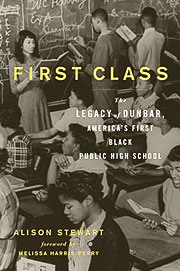First off, I apologize for the unplanned blog hiatus. The last few months were the busy season at the day job. But what better time to re-boot than February?
Black Women’s History on Twitter
It warmed my heart to see the #BlackFemStory hashtag pop up on Twitter yesterday. The Twitterverse showed love to Black women to kick off the first day of Black History Month. I was very happy to see that women from all over the diaspora were featured. This included a number of groundbreaking women in Africa, the Caribbean and Europe who were new to me. I encourage you to check it out.
 First Class & Dunbar High School
First Class & Dunbar High School
I received a number of books focusing on African-American history as Christmas gifts. You’ll see them featured here over the next few weeks as I read through them. First Class: The Legacy of Dunbar, America’s First Black Public High School by Alison Stewart was the first one I finished. Since it first opened in 1870 in Washington, D.C., the school has been known as Preparatory High School for Colored Youth, M Street High School, and Paul Laurence Dunbar High School. Dunbar has had an impressive roster of alumni and faculty in the past. Notables such as activist/educator Nannie Helen Burroughs, blood banking pioneer Dr. Charles Drew and “The Man Who Killed Jim Crow” legal scholar Charles Hamilton Houston were all graduates of the school. Former faculty included Anna Julia Cooper, Mary Church Terrell and Carter G. Woodson (who started Negro History Week, which eventually became Black History Month).
First Class covers the fascinating history of D.C. public schools, the rise of the D.C. African-American middle-class from the Reconstruction era to the Brown vs. Topeka Board of Education decision, and the decline of the school in the latter half of the twentieth century. I have always been fascinated by the story of this historic institution. It is amazing what the students and faculty were able to accomplish during the height of racial segregation in the United States. During the school’s heyday in the first half of the twentieth century, Dunbar’s graduates regularly went on to study at the top colleges and universities in the country. Stewart’s discussion of how outside politics had a direct effect on how the school turned into an academic powerhouse gave me a lot to think about. Anyone who has an interest in education and early twentieth century Washington, D.C. needs to check out this title.
Until next time,
Kaia
